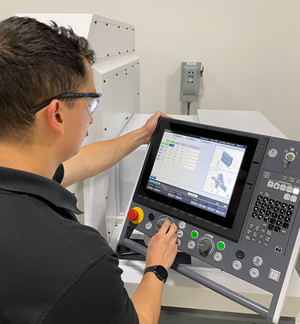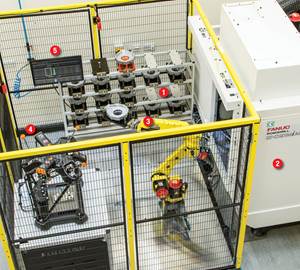Turning the Corner on Virtual Machining and Simulation
Simulation software’s effectiveness comes down to proper implementation and alignment with shop priorities.
Share






Reader Question: Our shop has adopted more complex equipment including five-axis mills and multitasking machines. Through some growing pains, we now know we need more robust simulation software but are uncomfortable with the cost. Can you help us turn the corner on this decision?
Miller’s Answer:
While simulation software has been around a while, admittedly I did not adopt it myself until more recently. Given my more production-focused background, I would perform my due diligence in the CAM environment, then do a careful prove out at the machine, but the process likely would run with the same program, workholding, tooling, in the same machine for one-to-five years. The utility versus cost of simulation software in my previous role was a much different equation than now, where I turn over different work for diverse customers in varying industries.
Today, I consider it a must for job shops, as it speeds up the parallel processing of work on the machine and the work in the office. Even more production-oriented shops are turning over more work across more hours on more complex machinery than ever. Due to the speed of CAM, automation and market demand, all of this happens at a breakneck pace, and often overnight when no one is around. Therefore, simulation tools as an aid and an insurance policy against that speed are a must.
As far as the hesitation for adoption, I suspect the hesitation to your concern is mostly cost, which is valid, but may also stem from perceived complexity with these packages and what they can or can’t do.
Regarding cost, yes, they can be very pricey, but I’d recommend not viewing it as software, but as an insurance policy for your machines. For example, you may need less insurance for a three-axis mill, as it has less risk factors for an expensive crash. Generally speaking, only the tool and vise can collide under normal conditions. Most three-axis machines can’t reach the spindle face to the table. However, a five-axis machine can crash into itself, such as spindle housings hitting rotary tables at odd angles. Since your shop has also adopted multitasking machines, this risk of collision may be even higher with spindles, subspindles, turrets and more all working in parallel. On the three-axis, catastrophe may only cost the spindle, but on the five-axis it could cost the spindle and rotaries, and the multitasking could require an entire rebuild. Therefore, the level of insurance you may or may not require changes. Compare the cost over time of the software, and the cost for an incident you are protecting against.
As far as complexity, there are layers to this as well as types to consider. First, verification software has two main types, which are “toolpath simulation” and “post simulation.” The industry has several terms for this so you may see other names, but essentially toolpath simulation just simulates the motion as generated by your toolpaths before being post processed into usable G and M code. This is more typical when the simulation is part of the CAM package itself. Post simulation means the simulation uses the G and M code and runs it in a virtual machine as if it were running on an actual machine. Both have their merits.
If you have multiple machines, types of machines, controllers and programmers, you may consider separate software, which simulates the actual code. If you have a smaller portfolio of machines and you trust your postprocessor for these machines, then toolpath simulation can work just as well.
Regardless of the type of simulation you may choose, they have the same primary function, which is crash prevention. However, there are many other benefits you may be overlooking, which could solidify your decision. First is training and allowing new machinists and programmers to take their lumps in the virtual world versus the real world. Another is optimization, because things often look different in real machine motion as opposed to the CAM environment, which is often just a visual of the material and carbide. A third benefit can be utilizing simulation for quoting purposes. Often simulation does a better job capturing actual machining time, because it’s including non-toolpath motion more accurately, and it has the added benefit of confirming stroke limits. Again, something might look reasonable in the CAM environment, but your perception of the workpiece when its in the machine could be quite different, and be the difference between a good profit or a loss when things don’t work out.
Balance this with some reality. Simulation is not a cure all for poor practices. The tools in the machine must match how they were setup in the virtual world, and the workholding must match as well.
Simulation software can be a game-changer for process security, efficiency and cost savings. For shops handling complex, high-value parts or running lights-out operations, it offers an essential layer of protection and optimization. However, smaller shops with simpler work may not see the same return on investment. Like any tool, its effectiveness comes down to proper implementation and alignment with shop priorities. If your shop is exploring virtual machining, take the time to assess the complexity of your parts, the cost of errors and the potential gains in efficiency before making the investment.
Related Content
Swiss-Type Control Uses CNC Data to Improve Efficiency
Advanced controls for Swiss-type CNC lathes uses machine data to prevent tool collisions, saving setup time and scrap costs.
Read More5 Stages of a Closed-Loop CNC Machining Cell
Controlling variability in a closed-loop manufacturing process requires inspection data collected before, during and immediately after machining — and a means to act on that data in real time. Here’s one system that accomplishes this.
Read MoreProcess Control — Leveraging Machine Shop Connectivity in Real Time
Renishaw Central, the company’s new end-to-end process control software, offers a new methodology for producing families of parts through actionable data.
Read MoreProtecting Your Automation Investments
Shops need to look at their people, processes and technology to get the most of out their automation systems.
Read MoreRead Next
How I Made It: Dennis Rymanowski
Dennis Rymanowski has worked at NSH USA for 60 years, with his passion for manufacturing living alongside his passion for his family’s polka band.
Read MoreA New Frontier in Surface Finish Control
What if your machine tool could measure surface roughness as it cuts? This article explores how in-process metrology is advancing from concept to reality, enabling real-time feedback, immediate detection of anomalies and new levels of control over surface quality. Discover the technologies making this possible.
Read More





















